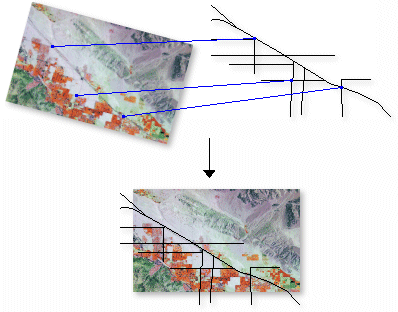Raster data is commonly obtained by scanning maps, collecting aerial photographs, and obtaining raw satellite images. Scanned map datasets don't usually contain information (either embedded in the tile or as a separate file) about where the area fits on the surface of the earth. The locational information delivered with raw aerial photographs and satellite imagery is often inadequate to perform analysis or display in proper alignment with other data. To use these types of raster data in conjunction with spatial data, you often need to align it, or georeference it, to a map coordinate system.
When you georeference a raster dataset, you define how the data is situated using map coordinates. Georeferencing is specified by linking the from points to the to points. This process includes assigning a coordinate system that associates the data with a specific location on the earth. Georeferencing raster data allows it to be viewed, queried, and analyzed with other geographic data.
The image below shows how two datasets that are not overlapping can be georeferenced (using links) to create two datasets that are overlapping. Once the datasets are overlapping, they are more useful for analysis and display.

Another method to georeference an image is to shift the image. Shifting an image is useful if the raster data is in the correct orientation and scale but needs to be shifted to a new geographic location. The image below shows an example of a raster dataset that is shifted. The first image shows that the street polylines do not align properly with the raster image. The second image shows the raster dataset shifted to align with the streets properly.
